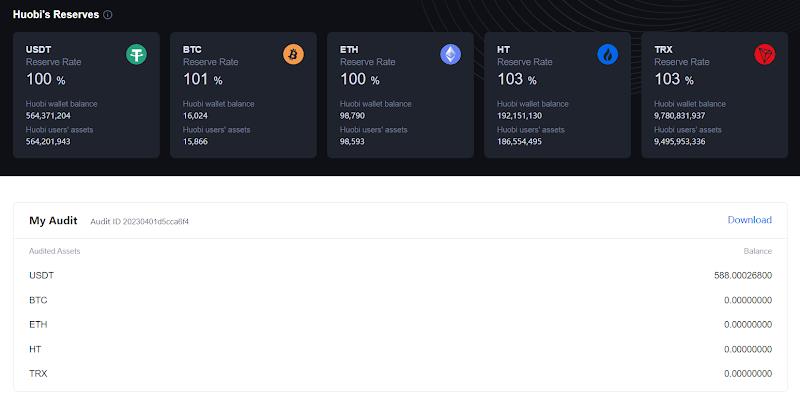(MENAFN- News Direct) Singapore | April 14, 2023 02:24 AM Eastern Daylight Time Singapore / April 14, 2023 / According to the latest news, Huobi completed thedevelopment of the Merkle Tree on December 2022 and adopted it months ago for Proof of Reserves (POR), enabling users to verify that their virtual assets are fully backed (1:1) on the platform. The launch of this service realizes an open-source verification of the Merkle Tree, wallet address ownership, and on-chain assets. Users can view Huobi reserves such as USDT, BTC, ETH, HT, and TRX in detail on the asset audit page of huobi's official website , including reserve ratio, Huobi wallet's assets, and Huobi's user assets. Huobi will regularly conduct Proof of Reserve audits to ensure users that their assets are safeguarded.

* The screenshot is taken from Huobi's official website and users can view the reserves on this page.
The purpose of the Merkle Tree adopted by Huobi is to summarize and verify the existence and integrity of block data in a timely manner. It typically contains the underlying (transaction) database of the block, the hash of the block header (the Merkle Root), and all branches along with the underlying block data to the root. The calculation of the Merkle Root for a block generally involves grouping hash values of the data of that specific block, then inserting the newly generated hash into the Merkle Tree recursively until only the last root hash remains. After that, it is recorded as the Merkle Root of the block header.
According to“Theory of Proof of Reserves" on Huobi's official website, Proof of Reserves (PoR) is a common audit method used to ensure that a crypto exchange holds sufficient on-chain funds to cover all assets held on it. Here is how the Huobi Merkle Tree works:
Snapshots of all user balances are taken in order to generate a Merkle Tree. The Merkle Tree contains the encrypted data of assets held by all users in the exchange. The Merkle Root is acquired from the Merkle Tree and contains a single hash containing total balances in the snapshots. Then, the digital signatures of Huobi's on-chain wallet addresses are verified to prove ownership over the addresses which obtain publically verifiable balances. Finally, the total balances held in on-chain wallet addresses are compared with the total balances provided by the Merkle Root to verify whether all assets are backed 1:1 by Huobi's reserves.

*The picture comes from Huobi's official website and helps explain the above theory.It has been reported that the FTX crisis brought attention to the debate and disapproval of centralized exchanges' methods for asset custody. At the very beginning of this incident, Huobi took the lead in announcing the launch of a "Merkle Tree Proof" to ensure the transparency of the asset reserves. Four days later, Huobi unveiled major asset reserves in both their hot and cold wallets and stated that it would announce the Merkle Tree PoR method including a 100% reserve audit within a month. Huobi always prioritizes the principle of "safeguarding user assets" while promising 100% delivery of assets, which was reiterated in its open letter.
By disclosing the reserve's details to the public and allowing users to view them at any time, Huobi has fulfilled its promise of always putting the safety of user assets first. Allowing users to know about their assets is a priority and mainstream practice aimed at "Winning Users' Trust." Huobi will also build a more transparent firewall with cutting-edge technologies and strict adherence to safeguard user assets.
In addition, Huobi has also joined hands with a number of key players in the industry to strengthen the security of user assets with innovative technologies, creating a secure and high-quality trading environment for users. Previously, Huobi reached a strategic partnership with Fireblocks and joined its OFF-Exchange settlement network to lower counterparty risks. Also, Huobi joined hands with other MPC wallet builders to secure user assets with advanced MPC technology and Threshold Signature Scheme (TSS).
Huobi leadership stated that, "In order to ensure data transparency and accuracy, the relevant reserves data on the asset audit page is currently updated once a month with the snapshot date generally on the first day of each month. The Merkle Tree data update is normally completed within the first week of each month." They also emphasized, "In the future, we will also optimize relevant technical modules and join hands with more technical service providers to achieve a more secure and transparent service. It is Huobi's mission to follow the strategy of 'global compliance' and bolster a healthy development of the crypto industry."
About Huobi
Founded in 2013, Huobi has evolved from a crypto exchange into a comprehensive ecosystem of blockchain businesses that span digital asset trading, financial derivatives, wallets, research, investment, incubation and other areas. Huobi serves millions of users worldwide, with a business presence covering over 160 countries and regions across five continents. Its three development strategies - "global development, technology drives development, and technology for good" - underpin its commitment to providing comprehensive services and values to global cryptocurrency enthusiasts.




















Comments
No comment